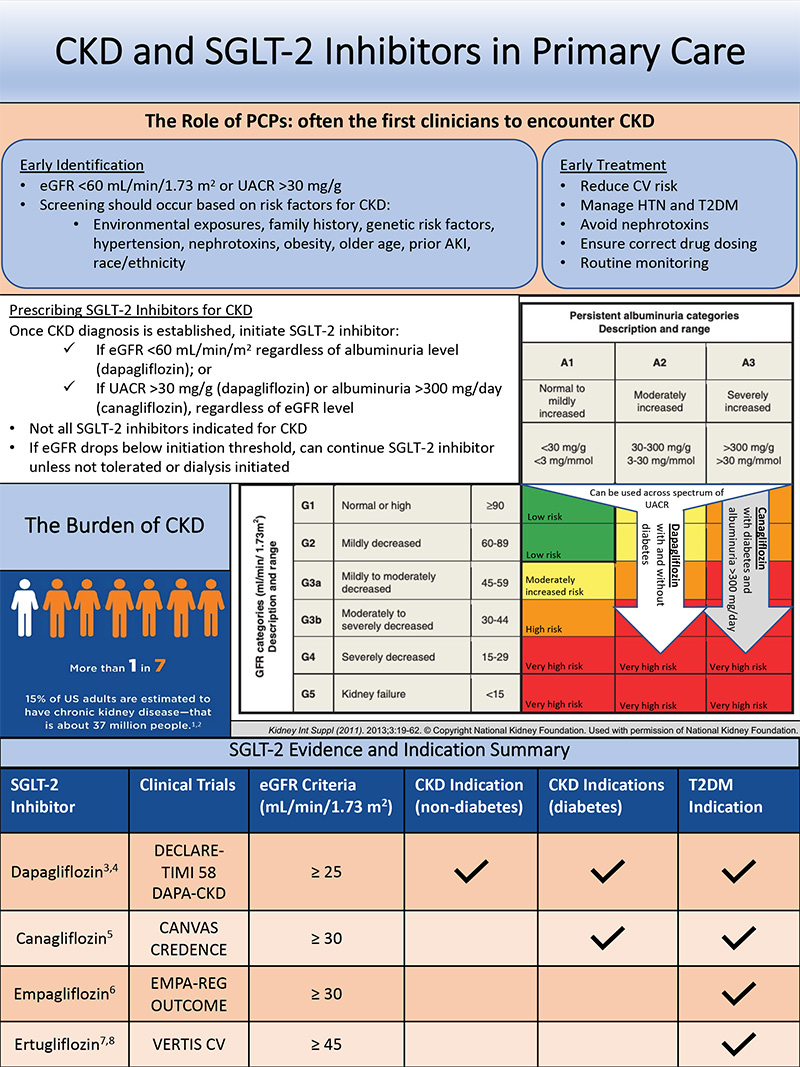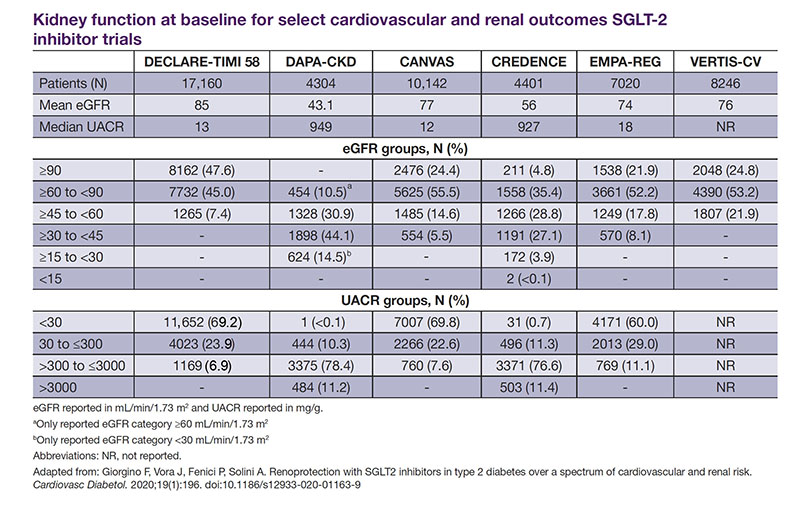Use of SGLT-2 Inhibitors to Treat Chronic Kidney Disease in Primary Care
The following illustrations, tables, and references are provided as resources in support of the article "Use of SGLT-2 Inhibitors to Treat Chronic Kidney Disease in Primary Care" by George Bakris, MD, Professor of Medicine, Director, AHA Comprehensive Hypertension Center, The University of Chicago Medicine, published in the "Hot Topics in Primary Care 2022" supplement to the July/August 2022 edition of The Journal of Family Practice, which you can read here. [Depending on your browser settings, PDF will open in new window or download for Acrobat Reader.]
CKD and SGLT-2 Inhibitors in Primary Care

Click image to open full size in new window. Infographic references below.
Kidney function at baseline for select cardiovascular and renal outcomes SGLT-2
inhibitor trials

Click image to open full size in new window.
This table is adapted from the article, "Renoprotection with SGLT2 inhibitors in type 2 diabetes over a spectrum of cardiovascular and renal risk" in Cardiovascular Diabetology, and is available here.
Definition and classification of CKD
CKD is defined as abnormalities of kidney structure or function, present for >3 months, with implications for health. The criteria for definition of CKD are objective and can be ascertained by means of simple laboratory tests without identification of the cause of disease, thereby enabling detection of CKD by non-nephrologist physicians and other health professionals.
This collection of 15 figures and discussions from Kidney International Supplements and the International Nephrology Society will give you a fast but thorough visual introduction to the classification and risk stratification to a broad range of abnormalities observed during clinical assessment. Not all of them have immediate health implications, but some may precede reduction in kidney function.
Chronic Kidney Disease Diagnosis and Management: A Review
In developed countries, CKD is most commonly attributed to diabetes and hypertension. However, less than 5% of patients with early CKD report awareness of their disease. Among individuals diagnosed as having CKD, staging and new risk assessment tools that incorporate GFR and albuminuria can help guide treatment, monitoring, and referral strategies. This overview originally published in the Journal of the American Medical Association shows how critical the diagnosis, staging, and appropriate referral of CKD by primary care clinicians is for reducing the burden of CKD worldwide.
The case for early identification and intervention of chronic kidney disease: conclusions from a Kidney Disease: Improving Global Outcomes (KDIGO) Controversies Conference
Unlike other chronic diseases with established strategies for screening, there has been no consensus on whether health systems and governments should prioritize early identification and intervention for CKD. Guidelines on evaluating and managing early CKD are available but have not been universally adopted in the absence of incentives or quality measures for prioritizing CKD care.
In 2019, Kidney Disease: Improving Global Outcomes (KDIGO) held a controversies conference entitled “Early Identification and Intervention in CKD.” Participants identified strategies for screening, risk stratification, and treatment for early CKD and the key health system and economic factors for implementing these processes. A consensus emerged that CKD screening coupled with risk stratification and treatment should be implemented immediately for high-risk persons and that this should ideally occur in primary or community care settings with tailoring to the local context.
Patient Awareness of Chronic Kidney Disease: Trends and Predictors
The impact of recent guidelines for early detection and prevention of chronic kidney disease (CKD) on patient awareness of disease and factors that might be associated with awareness have not been well described. Potential predictors of awareness included demographics, access to care, and clinical and lifestyle factors, which were assessed by standardized interviewer-administered questionnaires and physical examinations, but renewed and innovative efforts should be made to increase CKD awareness among patients and health care providers.
SGLT2 Inhibition for CKD and Cardiovascular Disease in Type 2 Diabetes: Report of a Scientific Workshop Sponsored by the National Kidney Foundation
Diabetes is the most frequent cause of chronic kidney disease (CKD), leading to nearly half of all cases of kidney failure requiring replacement therapy. The principal cause of death among patients with diabetes and CKD is cardiovascular disease (CVD). Sodium/glucose cotransporter 2 (SGLT2) inhibitors were developed to lower blood glucose levels by inhibiting glucose reabsorption in the proximal tubule. In clinical trials designed to demonstrate the CVD safety of SGLT2 inhibitors in type 2 diabetes mellitus (T2DM), consistent reductions in risks for secondary kidney disease end points, along with reductions in CVD events, were observed.
Chronic Kidney Disease and Risk Management: Standards of Medical Care in Diabetes-2022
The American Diabetes Association "Standards of Medical Care in Diabetes" includes the ADA's current clinical practice recommendations and is intended to provide the components of diabetes care, general treatment goals and guidelines, and tools to evaluate quality of care.
Cardiorenal Protection With the Newer Antidiabetic Agents in Patients With Diabetes and Chronic Kidney Disease: A Scientific Statement From the American Heart Association
Despite the widespread use of standard-of-care therapies for CKD with T2D over the past few decades, rates of progression to end-stage kidney disease remain high with no beneficial impact on its accompanying burden of cardiovascular disease. The advent of the newer classes of antihyperglycemic agents, including SGLT2 inhibitors and GLP-1 receptor agonists, has changed the landscape of therapeutic options for patients with CKD with T2D
Tangri, N., Peach, E.J., Franzén, S. et al. Patient Management and Clinical Outcomes Associated with a Recorded Diagnosis of Stage 3 Chronic Kidney Disease: The REVEAL-CKD Study, Adv Ther (2023).
References for "CKD and SGLT-2 Inhibitors in Primary Care" Infographic:
1. Jha V, Garcia-Garcia G, Iseki K, et al. Chronic kidney disease: global dimension and perspectives.
The Lancet. 2013;382(9888):260-272. doi:10.1016/S0140-6736(13)60687-X
2. Chronic Kidney Disease in the United States, 2021. Published July 8, 2021. Accessed
December 10, 2021. https://www.cdc.gov/kidneydisease/publications-resources/ckdnational-
facts.html
3. Jhund PS, Solomon SD, Docherty KF, et al. Efficacy of dapagliflozin on renal function and
outcomes in patients with heart failure with reduced ejection fraction: results of DAPAHF.
Circulation. 2021;143(4):298-309. doi:10.1161/CIRCULATIONAHA.120.050391
4. Heerspink HJL, Stefánsson BV, Correa-Rotter R, et al. Dapagliflozin in patients with
chronic kidney disease. N Engl J Med. 2020;383(15):1436-1446. doi:10.1056/NEJMoa2024816
5. Neal B, Perkovic V, Mahaffey KW, et al. Canagliflozin and cardiovascular and renal events
in type 2 diabetes. N Engl J Med. 2017;377(7):644-657. doi:10.1056/NEJMoa1611925
6. EMPA-KIDNEY (The Study of Heart and Kidney Protection With Empagliflozin).
NCT03594110. ClinicalTrials.gov. Updated March 9, 2022. Accessed March 17, 2022.
https://clinicaltrials.gov/ct2/show/NCT03594110
7. Cannon CP, Pratley R, Dagogo-Jack S, et al. Cardiovascular outcomes with ertugliflozin in
type 2 diabetes. N Engl J Med. 2020;383(15):1425-1435. doi:10.1056/NEJMoa2004967
8. Cherney DZI, Charbonnel B, Cosentino F, et al. Effects of ertugliflozin on kidney composite
outcomes, renal function and albuminuria in patients with type 2 diabetes mellitus:
an analysis from the randomised VERTIS CV trial. Diabetologia. 2021;64(6):1256-1267.
doi:10.1007/s00125-021-05407-5